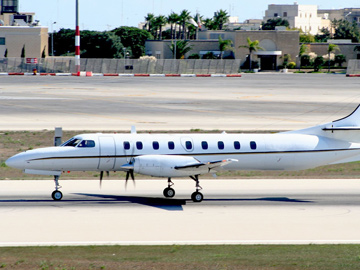
An incident on 30 January 2013 involving a Fairchild Metro aircraft, flying freight from Melbourne to Launceston highlights the importance of correctly loading freight aircraft.
Before the flight, the pilot conducted his flight planning away from the aircraft and prepared a trim sheet to confirm the weight and balance information (The trim sheet or loading plan contains directions to the loaders to ensure that freight is correctly distributed on the aircraft so that it can remain within the centre of gravity range while in flight.) He supplied this to the freight company that prepared a loading plan for the aircraft. When the pilot arrived at the aircraft the freight had been loaded, all cargo access doors had been closed and the cargo support strut (tail stand) had been removed. The pilot completed pre-flight checks and removed the wheel chocks and wing tip safety markers, before taking off.
While taking off, the pilot experienced difficulty achieving the correct trim. During the flight the auto-pilot struggled to maintain straight and level flight resulting in the aircraft ‘porpoising.’
While taking off, the pilot experienced difficulty achieving the correct trim. During the flight the auto-pilot struggled to maintain straight and level flight resulting in the aircraft ‘porpoising.’ The pilot conducted a normal landing in Launceston.
After landing, the pilot investigated the freight loaded in the nose of the aircraft and discovered that the locker only contained 35 kg of freight when it should have contained about 100 kg. The loading plan had indicated that there should be 100 kg in the nose locker but one of the loaders had removed about 70 kg and placed the cargo in the rear of the aircraft. This resulted in a rearward centre of gravity during the flight.
After investigating this incident, the operator found that:
- freight transferred from other flights had not been re-weighed,
- marked weight on freight pallets did not indicate whether it was gross or net
- the supervisor and ground personnel were not trained in loading procedures for the aircraft
- there was no strict control on the weight being loaded into each zone of the aircraft
- loaders were estimating freight weights going into each zone
- there were no procedures available for where to load cargo when the zone could no longer fit the cargo allocated to it.
As a result of this incident, the aircraft operator took action to issue a safety alert to all pilots requiring them to remove the cargo support strut and check the aircraft is loaded in accordance with the loading plan. They also undertook extensive improvements to documentation, training, audit, risk management, change management and project plans to improve ground handling and organisational safety.
Read the final report: Weight and balance event involving Fairchild SA-227AC, VH-UUO, Melbourne Airport, Victoria, on 30 January 2013


